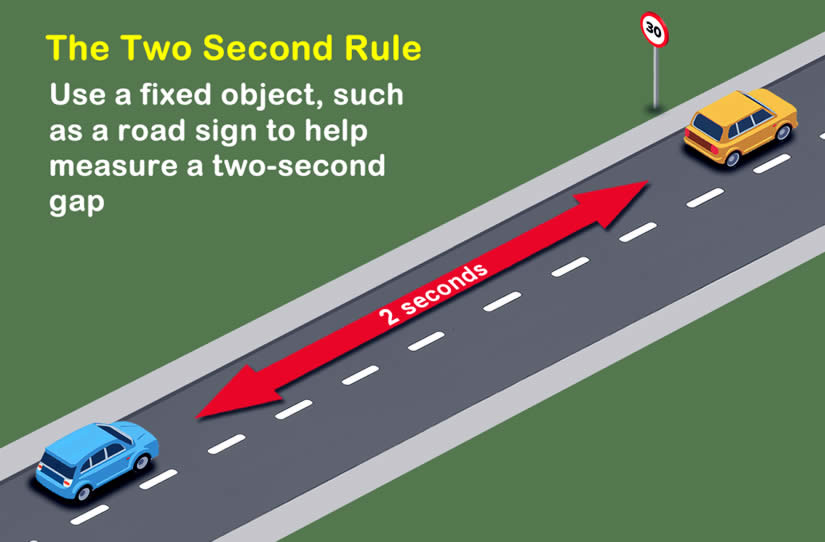On our roads, one of the most common causes of collisions is due to a lack of space between vehicles. The 2 second rule is a driving technique that’s easy to use and that helps to maintain a safe following distance.
By maintaining at least a 2 second gap from the vehicle in front, those that follow the 2 second rule will give themselves a suitable reaction time to avoid a collision with the vehicle ahead.
How To Do the 2 Second Rule
- Wait for the vehicle ahead to pass a fixed object
- Count for 2 seconds
- If you’ve passed the object before you’ve finished counting, it means you’re too close
To follow the 2 second rule, all you need to do is wait for the vehicle ahead to pass a fixed object close to the road, such as a traffic sign or lamp post. Then, simply count 2 seconds. If you want another way of estimating 2 seconds, say to yourself; ‘only a fool breaks the 2 second rule’ at your normal talking speed, as this phrase takes around 2 seconds to complete.
If you have passed that same fixed point before you’ve finished counting to 2, or before you’ve finished saying the phrase, it means you’re too close and need to increase the distance between you and the vehicle ahead. Check your mirrors and if safe to do so, slowly increase the gap between you and the vehicle ahead and try again.
Why is the 2 Second Rule Important?
There are over 400,000 rear-end collisions in the UK every year. Although most tailgating is unintentional, many of these collisions are due to drivers simply not leaving enough space between themselves and the vehicle in front. The 2 second rule is important as it provides a simple method that all drivers can follow to enable them a safe distance from the vehicle ahead.
For many, it’s not only difficult to remember the various stopping distances, but it’s also difficult to assess how far they are. This is where the 2 second rule works, it’s easy to remember and easy to accomplish.
Is the 2 Second Rule Accurate?
The 2 second rule is a rough guide and does not replicate the Highway Code’s stopping distances. The Highway Code stopping distances are as follows:
| Speed | Stopping Distance |
|---|---|
| 20 mph | 12 metres (40 feet) |
| 30 mph | 23 metres (75 feet) |
| 40 mph | 36 metres (118 feet) |
| 50 mph | 53 metres (174 feet) |
| 60 mph | 73 metres (240 feet) |
| 70 mph | 96 metres (315 feet) |
By following the 2 second rule and therefore leaving a 2 second gap between you and the vehicle in front, at slower speeds you will be further back than the Highway Code stopping distances and at higher speeds, you’ll be considerably closer. For a comparison with the Highway Code stopping distances, this is how many metres the 2 second rule gap is:
| Speed | Stopping Distance using the 2 Second Rule |
|---|---|
| 20 mph | 17.9 metres (58′ 7″ feet) |
| 30 mph | 26.8 metres (87′ 9″ feet) |
| 40 mph | 35.8 metres (117′ 4″ feet) |
| 50 mph | 44.7 metres (146′ 6″ feet) |
| 60 mph | 53.6 metres (175′ 8″ feet) |
| 70 mph | 62.6 metres (205′ 3″ feet) |
To maintain the identical stopping distances as the Highway Code, the 2 second gap would in fact need to be variable, depending on speed. Using the same speeds and stopping distances as the Highway Code, we can see the variation in the amount of time required to achieve the same results.
| Speed | Stopping Distance | Time (Seconds) |
|---|---|---|
| 20 mph | 12 metres (40 feet) | 1.3 |
| 30 mph | 23 metres (75 feet) | 1.7 |
| 40 mph | 36 metres (118 feet) | 2 |
| 50 mph | 53 metres (174 feet) | 2.4 |
| 60 mph | 73 metres (240 feet) | 2.7 |
| 70 mph | 96 metres (315 feet) | 3.1 |
The 2 second rule is not accurate in terms of replicating the Highway Code stopping distances. But in terms of simplicity, it does offer drivers a method of determining a safer following distance to at least to improve their reaction time to the vehicle ahead. Perhaps in keeping with simplicity, the 2 second rule could be increased to 3 seconds for speeds above 40 mph.
What is the 3 Second Rule?
In principle, the 3 second rule is the same as the 2 second rule. In certain parts of the world, they consider leaving a 3 seconds gap the minimum safe distance between you and the vehicle in front.
When Should You Leave Two Second Gap?
When driving in dry conditions, you should always leave at least a 2 second gap between you and the vehicle in front.
Is There a 4 Second Rule in Driving?
The 4 second rule should be used when roads are wet. Wet roads can be slippery and vehicles cannot stop in the same amount of time as in dry conditions. When roads are wet allow for a 4 second gap between you and the vehicle in front. During icy conditions, the 4 second rule should be extended even further.
